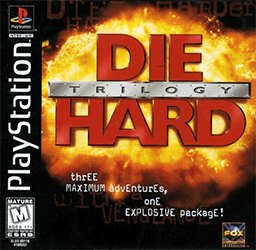Die Hard Trilogy facts for kids
Quick facts for kids Die Hard Trilogy |
|
|---|---|
 |
|
| Developer(s) | Probe Entertainment |
| Publisher(s) | Fox Interactive |
| Platform(s) | PlayStation, Microsoft Windows, Sega Saturn |
| Release date(s) | PlayStation Windows & Sega Saturn |
| Genre(s) | Third-person shooter Light gun shooter Driving |
| Mode(s) | Single-player |
Die Hard Trilogy is an exciting action video game that came out in 1996. It's based on the first three movies from the famous Die Hard series. What makes this game special is that it's actually three games in one! Each part is based on a different movie and has its own unique style of gameplay.
This game was very popular and sold many copies. It even became a "PlayStation Greatest Hits" and "PlayStation Platinum" title, which means it was a big success. Later, a sequel called Die Hard Trilogy 2: Viva Las Vegas was made. That game also had three different styles of play, but it told a new story not connected to the movies.
Contents
Gameplay
Die Hard Trilogy lets you experience three different types of games, each inspired by a Die Hard movie.
Die Hard (First Movie Game)
The first part of the game is a third-person shooter. This means you see your character, John McClane, from behind as you play. Your mission is to fight bad guys and save people who are being held hostage. This part of the game takes place in the Nakatomi Plaza, just like in the first movie.
Die Hard 2: Die Harder (Second Movie Game)
The second game is an "on-rails shooter." In this type of game, your character moves automatically along a set path. You only control where you aim and shoot. You need to stop terrorists who have taken over Dulles Airport, which is the setting of the second film.
You can aim your shots using a game controller, a light gun (a special gun-shaped controller), or a computer mouse. It's interesting that this game worked with Sega's Stunner light gun on the Sega Saturn console.
Die Hard with a Vengeance (Third Movie Game)
The third game in the trilogy is all about driving! You get to drive different vehicles like a taxicab, a sports car, and even a dump truck. Your goal is to race through New York City to find and stop bombs before they explode. It's a race against time!
Development Story
The game was created by a company in the UK called Probe Entertainment. Interestingly, the driving part of the game, based on Die Hard with a Vengeance, was made first. It was originally planned to be its own game.
However, the publisher, Fox Interactive, wanted the game to be more connected to all the Die Hard movies. So, Probe Entertainment decided to add the other two game parts. At the same time, Probe was also working on another game called Alien Trilogy.
Because of this, the team making Die Hard Trilogy was smaller and used older equipment. But this actually gave them a lot of freedom! They could be very creative and make up ideas as they went along. They didn't have a strict plan from the start.
Making three different games at once was a big challenge for the team. They had to make some changes to make sure the game ran smoothly. For example, in the Die Hard 2 part, they first tried to make enemies using polygons (3D shapes). But they later changed them to sprites (2D images) to make the game run better.
For the New York City driving part, the team wanted to make a very real-looking city. But they found that when driving super fast, a perfectly accurate city felt too small. So, they had to divide the city into sections and load them as you drove. This helped make the game feel bigger and faster.
The PlayStation was chosen as the main console for the game because the developers thought it was the most powerful at the time. They believed that if the game looked great on PlayStation, it would be easier to make good versions for other consoles like the Sega Saturn and PC.

